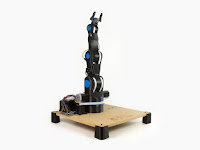I stumbled across the Evezor Kickstarter page recently and was fascinated to see the range of things this SCARA arm can do. It can 3d print, carve or mill like a CNC machine, laser-engrave, pick and place electronic parts, paint or draw, and more. It also appears on Thingiverse.
There are Youtube videos of many of these operations. The resolution is good. The effective build volume is enormous. The speed is decent. As I watched more videos, I got a little bit obsessed with the whole thing and decided to blog about it.
The Kickstarter campaign was regrettably unsuccessful. You can still pre-order one for $2650, but I can't justify an expense like that currently, and I suspect the lead time would be substantial.
In the midst of my obsession, I started poking around the interwebs to see what other similar projects might exist, and might be more affordable as well as open source, and came across quite a few.
Several arms work like a Luxo lamp, using parallelograms along the arm segments to keep the end effector in a consistently vertical orientation.
- EEZYbot Arm MK2

- Tertiam, built from an Ikea Tertial lamp (basically a Luxo lamp)

- A mostly-printed desktop robot arm

- An early-model uArm, now available at SparkFun for $340

- One more, available from Tindie for $350

These are all appealing for cost reasons, but I worry about the resolution. They'd be fine for picking up small objects, and maybe some drawing, but I'd be surprised if they could do 3d printing or CNC milling with a Dremel tool.
There are a couple other SCARA arms. These are more commercial and expensive, and don't appear to be open source. But for that price they probably have the resolution. I found a couple more that were neither Luxo-style nor SCARA.
There are a couple other SCARA arms. These are more commercial and expensive, and don't appear to be open source. But for that price they probably have the resolution. I found a couple more that were neither Luxo-style nor SCARA.
- An "open dobot" project on Github, probably from a deprecated older Dobot product.

- The BCN3D Moveo on Thingiverse



